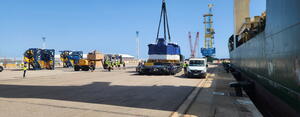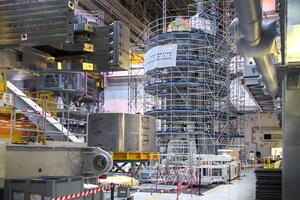The last module for the stack
ITER's assembly wizards will soon have all the elements they need to complete the central solenoid tower.
The United States has delivered the sixth and final module needed to complete the ITER central solenoid to the French port of Fos-sur-Mer and the component will arrive at the ITER site next week. The milestone event marks the culmination of more than a decade of engineering, design and fabrication for the first-of-its-kind pulsed superconducting magnet that will sit at the centre of the ITER tokamak.
“This is another example of how the ITER project is moving fusion technology and industry forward in the United States and the world, preparing us for a future with practical fusion energy," said Kevin Freudenberg, the US ITER technical director. Freudenberg has been part of the US ITER project since 2007, when he started as the lead analyst for magnet systems.
Currently, four of the six modules are stacked and connected in the ITER Assembly Hall. The fifth module has passed site acceptance testing and is being prepared to be added to the stack; the sixth and final module will be placed atop the stack by year end. A spare module is also scheduled to arrive at the ITER site by the end of December.
Once completed, the superconducting magnet will stand as tall as a five-story building and weigh 1,000 tonnes.
US ITER staff oversaw the design and fabrication of the central solenoid, with the modules fabricated by General Atomics in Poway, California. More than a dozen US companies and organizations also contributed to the superconducting magnet, its support structure and tooling, including ARMEC Corp (Tennessee); Climax (Oregon); Cryomagnetics (Tennessee); Hamill Manufacturing Co. (Pennsylvania); Kamatics Corporation (Connecticut); Keller Technology Corporation (New York); Major Tool and Machine (Indiana); National High Magnetic Field Laboratory (Florida); Petersen, Inc. (Utah); Precision Custom Components (Pennsylvania); Rhinestahl (Ohio); Robatel Technologies (Virginia); and Superbolt, Inc. (Pennsylvania).
The central solenoid is one of 13 essential hardware systems that the United States is contributing to ITER through the US ITER project, which is managed by Oak Ridge National Laboratory on behalf of the US Department of Energy Office of Science, with contributions from Princeton Plasma Physics Laboratory and Savannah River National Laboratory. Altogether, more than 600 companies across the United States have contributed to ITER hardware systems.
“With the work of our central solenoid team spanning over a decade, the end of one era is drawing near while another begins,” said David Vandergriff, a senior project engineer who has been part of the central solenoid team since joining US ITER in 2016. “This is the culmination of our working toward a common goal of creating the central solenoid to be the heartbeat of ITER, which we think has the potential to change how the world creates and generates energy.”
A celebration for central solenoid completion was held in late August at General Atomics. See this video to learn more about the role of the central solenoid in ITER.



